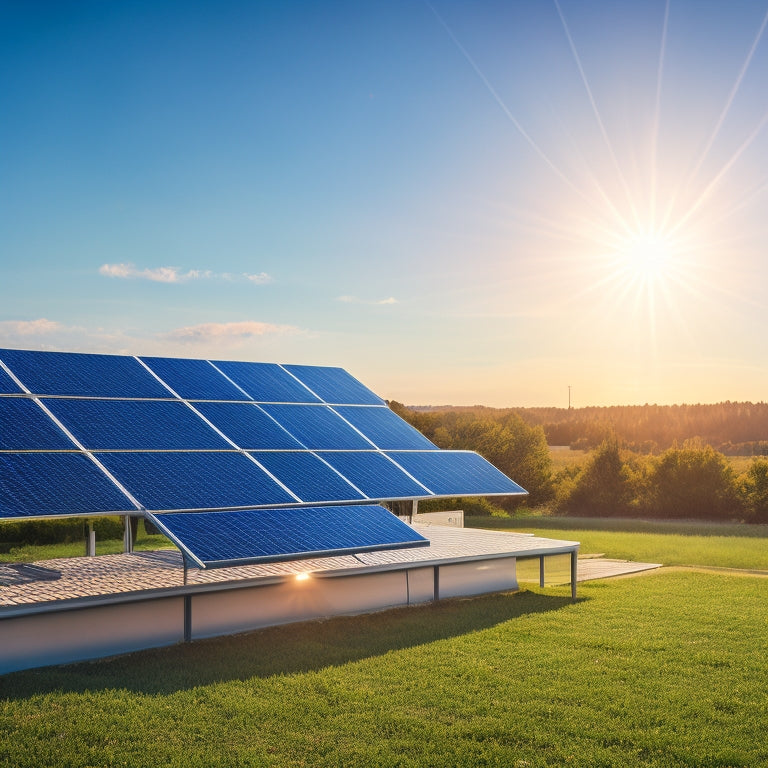
Optimizing Solar Panel Systems With Energy Storage
Share
To optimize your solar panel system with energy storage, balance your energy supply and maximize efficiency. Choose the right batteries by evaluating capacity, lifespan, and cost-efficiency. Integrate solar panels and storage units to store excess energy for use during peak times. Employ real-time data analysis and predictive analytics for continual performance assessment. Follow best installation practices, like ideal panel alignment and efficient wiring. Focus on high-efficiency inverters and conduct thorough energy audits. Plan components meticulously for top performance and long-term savings await you once you efficiently link solar energy with storage. Discover more strategies for superior energy optimization.
Key Takeaways
- Assess roof orientation and tilt to maximize solar panel sunlight capture.
- Utilize high-efficiency inverters to minimize energy loss during conversion.
- Implement real-time data analysis for continuous performance optimization.
- Place energy storage units in ideal conditions for optimal longevity and efficiency.
- Regularly monitor and adjust system settings for peak energy production and storage.
Benefits of Energy Storage
https://www.youtube.com/watch?v=z-k5uS7ALXk
Energy storage systems offer several critical benefits, including enhanced grid stability and improved energy efficiency for solar panel installations. By integrating energy storage into your solar setup, you can achieve significant grid independence. This means you're less reliant on the traditional power grid, giving you more control over your energy production and consumption.
You'll store excess energy generated during peak sunlight hours and use it when your panels aren't producing enough power, maximizing your system's efficiency.
Moreover, energy storage provides robust blackout protection. In the event of a power outage, your stored energy can keep essential appliances and systems running, ensuring your home remains functional and comfortable. This capability is especially important in areas prone to frequent blackouts or extreme weather conditions.
From a sustainability perspective, energy storage systems contribute to a more resilient and eco-friendly energy infrastructure. By optimizing the use of renewable energy sources, you reduce your carbon footprint and lessen the strain on non-renewable energy resources.
In essence, adopting energy storage isn't just a technical upgrade; it's a step towards a liberated, self-sufficient energy future, empowering you to be a proactive participant in the global shift towards sustainability.
Choosing the Right Batteries
When selecting batteries for your solar panel system, you'll need to carefully assess battery capacity, lifespan, and cost-efficiency.
A high-capacity battery guarantees reliable power storage, while a durable, long-lasting battery minimizes replacements.
Balancing these factors with cost and efficiency will optimize your system's sustainability and performance.
Battery Capacity Considerations
Choosing the right batteries for your solar panel system hinges on understanding both your energy consumption patterns and the specific capabilities of each battery type. Effective load balancing and peak shaving are vital to maximizing your solar investment. By analyzing your daily and seasonal energy usage, you can determine the ideal battery capacity that meets your needs without over-investing.
Battery technology varies widely, from lead-acid to lithium-ion and beyond. Each type offers unique advantages. Lithium-ion batteries, for instance, are highly efficient and have a higher energy density, making them suitable for extensive load balancing and peak shaving. Their rapid charge and discharge rates align well with solar energy's intermittent nature, allowing you to store excess energy during peak sunlight hours and use it when demand spikes.
Consider the depth of discharge (DoD) and round-trip efficiency of potential batteries. Higher DoD means you can utilize more of the battery's capacity, while higher round-trip efficiency ensures minimal energy loss during storage and retrieval.
Sustainable choices not only reduce your dependence on the grid but also pave the way for energy independence. Make informed decisions to ensure your solar panel system meets both current and future energy demands.
Lifespan and Durability
Understanding battery capacity is just one piece of the puzzle; you must also evaluate the lifespan and durability to guarantee long-term reliability and cost-effectiveness.
When selecting batteries for your solar panel system, consider the material quality. Batteries constructed from high-grade materials not only last longer but also perform more consistently. Pay attention to the type of chemicals and metals used, as these will influence the battery's overall longevity and resilience.
Analyzing weather resistance is equally critical. Your energy storage system will be exposed to various environmental conditions, from scorching heat to freezing cold. A battery with robust weather resistance can withstand these extremes without significant degradation. Look for batteries that have high ingress protection (IP) ratings, which indicate their ability to resist dust and water.
Furthermore, you need to account for the battery's cycle life. This refers to the number of complete charge and discharge cycles a battery can undergo before its capacity notably diminishes. A higher cycle life means fewer replacements, reducing both your environmental footprint and overall costs.
Cost and Efficiency
To maximize both cost-efficiency and performance, you must carefully assess the initial investment against the long-term savings offered by various battery technologies. Achieving grid independence requires a strategic approach, balancing upfront costs with future benefits. Here's how you can make an informed decision:
-
Battery Type:
Lithium-ion batteries, though more expensive initially, offer higher efficiency and longer lifespan compared to lead-acid batteries. They reduce maintenance costs and deliver greater energy density, making them ideal for sustained energy storage. -
Capacity and Scalability:
Consider your energy needs and potential for expansion. Batteries with modular designs allow for easy scalability, accommodating future increases in energy consumption without a complete system overhaul. This flexibility ensures you're not constrained by your initial setup. -
Maintenance Costs:
Evaluate the ongoing maintenance requirements. Lithium-ion batteries typically require less maintenance than other types, translating to lower long-term costs. Regular maintenance can be a hidden expense that adds up over time, so choosing a low-maintenance option enhances overall cost-efficiency.
Integrating Solar and Storage
Integrating solar panels with energy storage systems maximizes efficiency by storing excess energy for use during periods of low sunlight or high demand. To achieve this, you'll need a well-thought-out system design that guarantees seamless operation.
Start by selecting an energy storage solution that complements your solar array's capacity and output. This includes determining the appropriate size of batteries and inverters to handle the energy flow effectively.
Grid integration is another vital aspect. By connecting your solar and storage setup to the grid, you can balance energy supply and demand more effectively. This integration allows you to sell excess energy back to the grid, contributing to a decentralized and sustainable energy network. It also provides a safety net during periods of extreme demand, enhancing grid reliability.
For a system that truly liberates you from energy constraints, make sure your components are compatible and optimized for peak performance. Use smart meters and energy management systems to monitor and control energy distribution efficiently. Emphasize sustainability by selecting eco-friendly materials and technologies.
With these strategies, your solar and storage system won't only elevate your energy independence but also contribute to a sustainable future.
Installation Best Practices
Ensuring a successful installation of solar panel systems with energy storage hinges on meticulous planning and adherence to industry standards. To achieve peak performance, you'll need to pay close attention to several key factors.
First, roof orientation is vital. Align your solar panels to maximize sunlight exposure. In the northern hemisphere, south-facing roofs capture the most sunlight. Make sure the roof's angle and any shading from nearby structures are carefully assessed.
Next, focus on efficient wiring techniques. Proper wiring minimizes energy loss and guarantees the system's safety. Use high-quality materials and keep wiring runs as short as possible to reduce resistance. Employ proper grounding and overcurrent protection to safeguard your investment.
Finally, integrate your energy storage seamlessly. Position storage units in a location that maintains ideal temperature and humidity levels. Make sure these units are easily accessible for maintenance but secure enough to prevent unauthorized access.
Consider these three critical steps for best results:
-
Assessing Roof Orientation: Maximize sunlight capture by aligning panels correctly.
-
Implementing Efficient Wiring Techniques: Use high-quality materials and minimize energy loss.
-
Placing Energy Storage Units: Ensure ideal conditions for longevity and safety.
Monitoring System Performance
You'll need to leverage real-time data analysis to assess your solar panel system's performance continuously.
By identifying inefficiencies quickly, you can implement targeted efficiency improvement strategies to maximize energy output and sustainability.
Regular monitoring guarantees that your system operates at peak performance, reducing both costs and environmental impact.
Real-time Data Analysis
To optimize the efficacy of your solar panel system, it's crucial to implement real-time data analysis for monitoring performance metrics continuously. By leveraging predictive analytics and data visualization, you can enhance the reliability and efficiency of your system. Real-time data analysis allows you to track performance, identify anomalies, and make informed decisions swiftly.
Here are three key components to keep in mind:
-
Data Acquisition: Utilize sensors and IoT devices to gather real-time data from your solar panels. This data includes metrics like energy output, panel temperature, and sunlight exposure, providing a thorough view of your system's performance.
-
Predictive Analytics: Implement predictive analytics to foresee potential issues before they impact your system. By analyzing historical and real-time data, you can predict maintenance needs, optimize energy storage, and improve overall efficiency.
-
Data Visualization: Employ advanced data visualization tools to present complex data in a user-friendly manner. Visual dashboards enable you to monitor trends, compare performance over time, and quickly identify any deviations from expected performance levels.
Efficiency Improvement Strategies
Monitoring your solar panel system's performance is pivotal for implementing efficiency improvement strategies that maximize energy output and longevity. By keeping a close eye on your system, you can swiftly identify and rectify issues that could hamper its effectiveness.
Integrating advanced monitoring tools allows you to track key metrics such as energy production, weather impact, and panel orientation.
Weather impact plays an essential role in your system's efficiency. By analyzing real-time weather data, you can predict periods of reduced sunlight and adjust your energy storage and usage accordingly. This proactive approach guarantees you make the most of sunny days while conserving stored energy for cloudy periods.
Panel orientation is another critical factor. Regularly checking the alignment and tilt of your panels in relation to the sun's position can significantly enhance efficiency. Automated tracking systems can dynamically adjust your panels throughout the day, optimizing their exposure to sunlight.
Additionally, monitoring software provides detailed performance reports, enabling you to fine-tune your system's settings. By understanding and acting on this data, you'll not only improve energy production but also prolong the lifespan of your solar panels, contributing to a more sustainable and liberated energy future.
Maximizing Energy Efficiency
Achieving peak energy efficiency in solar panel systems requires an integrated approach that combines advanced technology and strategic energy storage solutions. You need to meticulously plan each component to guarantee seamless integration and top performance. Start by focusing on the following critical steps:
-
Inverter Selection: Choose an inverter that matches your solar panel system's specifications. Look for high-efficiency models with low standby losses and robust monitoring capabilities. This will help convert DC power to AC power with minimal energy loss, maximizing the system's overall efficiency.
-
Energy Audits: Conduct thorough energy audits to identify inefficiencies in your existing setup. Detailed assessments will pinpoint areas where energy is wasted and recommend corrective actions. Regular audits ensure your system operates at peak efficiency and adapts to changing energy needs.
-
Smart Energy Storage: Implement advanced energy storage solutions like lithium-ion batteries or flow batteries. These systems store excess energy generated during peak sunlight hours for use during low production periods or at night. Smart storage management can greatly reduce reliance on the grid and enhance energy independence.
Cost Considerations and Savings
Investing in solar panel systems with energy storage necessitates a thorough analysis of initial costs, ongoing maintenance, and long-term savings to guarantee financial viability and sustainable energy use. You're looking at a notable initial investment, but various financing options, such as loans or leasing, can ease the burden. Calculating the payback period—how long it takes for your savings on energy bills to cover the initial costs—is vital.
Consider the following factors:
| Aspect | Considerations | Impact |
|---|---|---|
| Initial Investment | Equipment costs, installation fees | High upfront cost |
| Financing Options | Loans, leases, incentives | Spread out payments |
| Maintenance Costs | Regular upkeep, repairs | Moderate ongoing expenses |
| Energy Savings | Reduced utility bills | Long-term financial benefits |
| ROI Period | Payback time | Financial sustainability |
Using this table, you'll see that initial investments are high, but financing options can spread costs over time. Maintenance costs are relatively low compared to the savings you'll accrue on energy bills. Over the long term, energy savings greatly enhance your financial freedom, aligning with a sustainable lifestyle. Analyzing these factors helps ensure your solar energy system is both a sound financial decision and a step towards energy independence.
Future Trends in Solar Storage
Emerging advancements in battery technology and grid integration are poised to revolutionize solar storage systems, making them more efficient and cost-effective.
As you look to the future, consider these key trends shaping the landscape:
-
Next-Generation Batteries: Innovations in solid-state and lithium-sulfur batteries promise higher energy densities and longer lifespans. These advancements will boost grid reliability and reduce the overall costs of solar storage systems.
-
Smart Grid Integration: The integration of AI and machine learning into grid management will optimize energy distribution. This means your solar storage system can respond dynamically to demand fluctuations, enhancing both efficiency and reliability.
-
Policy Incentives: Governments worldwide are rolling out new policies and incentives aimed at accelerating the adoption of solar storage systems. From tax breaks to grants, these measures will make it more financially viable for you to invest in cutting-edge solar solutions.
Frequently Asked Questions
How Does Weather Impact Solar Panel Energy Production?
Weather forecasts are essential for solar panel efficiency. Cloud coverage greatly reduces energy production. By analyzing data, you can adjust expectations and improve sustainability. Embrace technology to maximize your energy independence and minimize your environmental impact.
What Are the Typical Maintenance Requirements for Solar Panel Systems?
To maintain your solar panel system efficient, establish regular cleaning schedules and conduct routine inverter inspections. This proactive maintenance guarantees peak performance and longevity, liberating you from excessive energy costs and contributing to a sustainable future.
Can Solar Panel Systems Be Used in Remote or Off-Grid Locations?
Imagine the freedom of living off the beaten path. You can absolutely use solar panel systems in remote locations. With sufficient battery capacity, you'll achieve grid independence and embrace a sustainable, self-sufficient lifestyle.
How Do Solar Panel Systems Integrate With Smart Home Technology?
You can integrate solar panel systems with smart home technology by using home automation and smart inverters. These components guarantee efficient energy management, enabling sustainable living and giving you greater control over your energy independence.
What Are the Environmental Benefits of Using Solar Energy?
You won't believe how drastically solar energy slashes your carbon footprint! It's a renewable resource that greatly reduces greenhouse gas emissions, cuts pollution, and promotes sustainability. Embrace solar to liberate yourself from fossil fuel dependency!
Related Posts
-
Trends in Renewable Energy Storage Technologies
You're witnessing rapid advancements in renewable energy storage technologies aimed at improving efficiency and scala...
-

Long-Term Cost Savings With Solar Panels
Investing in solar panels offers substantial long-term savings on energy costs. You'll benefit from federal tax credi...
-

Passive Solar Design Strategies for Homes
To effectively implement passive solar design strategies in your home, focus on ideal building orientation and strate...

